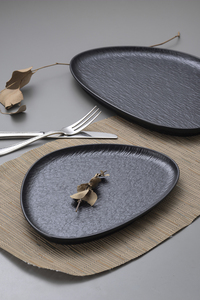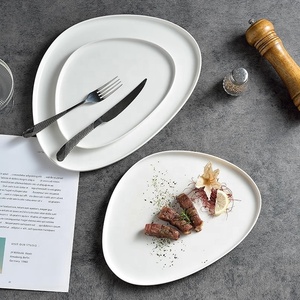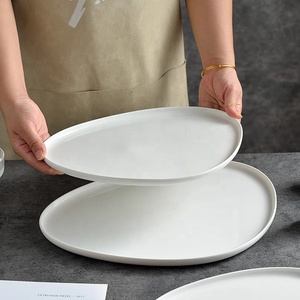(2165 products available)













































































































































































Melamine triangular plates
Melamine triangular dinner plates are made from melamine, a durable and versatile material often used in manufacturing kitchenware. Melamine is a hard resin that can withstand daily wear and tear, making these plates ideal for regular use. One of the key features of melamine triangular plates is their lightweight nature. Despite being lightweight, these plates have a sturdy construction and are less likely to chip or crack compared to traditional ceramic or glass plates. This durability makes them a popular choice for households with children or for outdoor dining.
Triangular ceramic plates
Triangular ceramic plates are a type of dinnerware made from ceramic material. Ceramics are generally known for their strength, heat resistance, and ability to retain and distribute heat evenly. Ceramic triangular plates are typically crafted through a process involving clay, which is shaped and then fired at a high temperature to solidify the clay and create a hard, durable material. Ceramic plates are beautiful and functional kitchenware. They are often used for serving food, appetizers, and desserts and can be found in various styles and designs to complement different table settings.
Stainless steel triangular plates
Stainless steel triangular plates are made from a corrosion-resistant alloy of steel, which is known for its strength, durability, and resistance to rust and staining. This material is commonly used in various kitchen tools and equipment due to its hygienic properties and ability to withstand high temperatures. Stainless steel plates are non-reactive, meaning they won't interact with acidic or alkaline foods, ensuring the taste and quality of the food remains unaffected. These plates are easy to clean and maintain, making them a popular choice for both commercial and residential kitchens.
Shape Variety:
Triangular plates come in a variety of shapes to accommodate diverse culinary and presentation needs. The standard triangle plates provide a consistent and familiar form, having equilateral and isosceles triangle shapes. On the other hand, the free-form triangle plates offer a more artistic and unconventional presentation option. These plates have irregular edges and asymmetrical shapes, making them perfect for avant-garde dishes and creative plating. Additionally, some triangular plates are designed with added compartments or structures, such as tiered or stacked plates, to showcase multiple components of a dish separately and creatively.
Material Options:
Triangular plates are made from a variety of materials to meet different usage scenarios and style preferences. Ceramic plates offer excellent heat retention and a classic look, making them ideal for formal dining and special occasions. At the same time, ceramic plates are easy to clean and maintain. Stainless steel plates are durable and corrosion-resistant, suitable for commercial kitchens and outdoor activities. In addition, stainless steel plates have a modern industrial style. Acrylic plates are lightweight and impact-resistant, making them suitable for children's dining and outdoor picnics. Acrylic plates also offer a variety of color and transparency options. Wooden plates provide a natural feel and insulation properties, suitable for serving snacks and appetizers. Wooden plates bring warmth and rustic charm to the table. No matter the material, triangular plates will add a unique culinary experience and visual effect to the meal.
Edge Treatment:
The edges of triangular plates can be treated in various ways to enhance aesthetics and usability. Triangular plates with embossed edges add a sense of elegance and refinement to the overall design. These plates are often used in high-end restaurants and special events. Plates with curved edges, on the other hand, are designed for safety and practicality, particularly suitable for children or outdoor activities. Flat-edge plates are typically used in everyday dining and casual gatherings, providing a more practical and comfortable option.
Serving Food
Triangular plates are used to serve foods like sushi, appetizers, and desserts.
Table Decor
In table decor, plate designers use triangular plates to make unique centerpieces and place settings. They can also be used to hold candles, small vases, or decorative accents.
Art Projects
Triangular plates can be used in various art projects, including mosaic making, painting, and creating unique displays.
Geometric Displays
Plate designers incorporate triangular plates into geometric displays to create visual interest and balance. Combining triangular plates with other geometric shapes can create eye-catching arrangements for events or exhibitions.
Fashion Shows
Plate designers use triangular plates as props in fashion shows to complement the runway presentation. Using these plates, stylish looks can be served, and artistic arrangements can be created on the catwalk.
Artistic Presentations
Triangular plates can be used in artistic presentations to create visually stunning food presentations. Chefs and food artists can arrange dishes on these plates to make them look great.
Special Events
Triangular plates can be used in special events for unique table settings and decorative elements. For example, at a wedding, a triangular plate can be used as a place card holder or favor container, adding charm and elegance to the celebration.
Choosing triangular plates for a brand's business is an important task. It involves considering different factors. These factors ensure that the tableware fits the user's needs. They also ensure that it matches the brand's image. Here are some key factors to consider when selecting these unique dishware:
Brand Image and Aesthetics:
The triangular plates should represent the brand's image. They should show the brand's values and personality. For example, a brand that cares about being green should pick plates. They should be made from eco-friendly materials. They should show sleek, modern designs. They should show vibrant colors or patterns that match the brand's theme. The tableware should go well with the restaurant's decor. It should fit in with the overall look and feel of the establishment.
Functionality:
The triangular tableware should be functional. They should work well for the dishes served. Their unique shape makes them great for modern presentations. When choosing triangular plates, consider their usability. They should provide enough space for food. They should allow for easy stacking and handling. The plate's edges should be practical for plating and eating. They should enhance the dining experience.
Material and Durability:
Choose triangular plates with materials that can withstand a busy kitchen. Popular choices are ceramic, porcelain, or stoneware. These materials are strong. They resist chipping and cracking. They can handle daily use. If the plates are for outdoor dining or casual dining events, consider acrylic or melamine plates. They are less likely to break in outdoor settings.
Ease of Cleaning:
The ease of cleaning the triangular plates is an important factor to consider. Choose plates that are dishwasher-safe. They have smooth surfaces. These features make them easier to clean. Plates with raised rims or unique shapes may make food debris get trapped. They may make cleaning more difficult.
Versatility:
The triangular plates should be versatile. They should work for different dishes and dining occasions. Choose plates with different sizes. They should fit various menus. They should allow for easy reconfiguration. The unique shape of the triangular plates may not fit all cuisines. Make sure they work well with the restaurant's concept.
Customer Experience:
The triangular plates should improve the customers' dining experience. They should be comfortable to use. The unique shape should create an interesting and memorable visual impact. Consider customer feedback. It may provide valuable insights into the plate's usability and appeal. Choose plates that align with the customers' preferences and expectations.
Q1: What are the advantages of using triangular plates?
A1: Triangular plates can add visual intrigue to a table setting, optimize space utilization, and offer unique presentation styles for dishes.
Q2: What materials are triangular plates commonly made from?
A2: Triangular plates are usually formed out of materials like porcelain, melamine, acrylic, glass, and stainless steel.
Q3: Can triangular plates be used in all culinary sectors?
A3: Triangular plates find application across the board in restaurants, catering, food trucks, and other commercial kitchens.
Q4: How can one stylishly use triangular plates?
A4: Triangular plates can be used for appetizers, salads, desserts, and creatively arranging main dishes or fusion meals.
Q5: Are triangular plates dishwasher and microwave safe?
A5: The sturdiness and resilience of triangular plates make them dishwasher and microwave-safe.